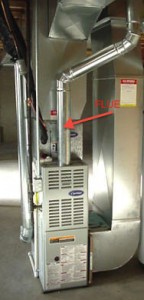Furnaces and Carbon Monoxide Poisoning – Be Aware
I think most homeowners are familiar with the “silent killer” carbon monoxide. We see the stories on TV. We buy the CO detectors. We hope we’re safe. Unfortunately, it seems most homeowners aren’t very familiar with what can cause this potentially life threatening issue to happen in their homes. Read on for more info on your furnace and carbon monoxide poisoning.
I read a very sad story this weekend about an older couple near Bloomington that clearly didn’t know what caused carbon monoxide poisoning in their home. The couple died from an apparent carbon monoxide leak in their furnace. Sadly, like most stories you will read like this, it was likely preventable.
How does this happen?
The two most common areas that we see carbon monoxide leaks are within the heat exchangers, and the exhaust flue.
 The flue should be the easiest to detect and and address, but many times it’s not. First, just so we’re clear, the flue is the round metal exhaust that comes from the top of your furnace, and should then go through a protected and enclosed space before exited and exhausting air from your home.
The flue should be the easiest to detect and and address, but many times it’s not. First, just so we’re clear, the flue is the round metal exhaust that comes from the top of your furnace, and should then go through a protected and enclosed space before exited and exhausting air from your home.
As you see in the picture, if your home has an 80% efficiency gas furnace, it will come installed with a metal flue. As a system ages, however, moisture can find it’s way into that metal flue. Where we see issues arising is when the metal rusts away and holes begin to develop. This is where the risk for carbon monoxide and other noxious gasses getting into your home become a much greater risk.
If you notice rust developing in or near your flue pipe, I wouldn’t wait to call a heating and cooling professional to inspect and correct the issue.
The second area where we see the risks of carbon monoxide leaks is within the heat exchangers of your furnace.
The heat exchangers are where the combustion process takes place in your gas furnace. That combustion air, is then supposed to be pulled from the system by the inducer motor to be expelled out the aforementioned flue pipe.
However, as we’ve discussed in the past, heat exchangers can develop cracks over time due to a series of reasons which can allow combustion air to be circulated into the home. Unfortunately because this cause is harder to detect, it can go unnoticed until a skilled technician with the right tools can find it. A cautionary note, some companies will try to use a cracked heat exchanger diagnosis as a tactic to push you into a new furnace. Any technician making the diagnosis of a cracked heat exchanger should be able to physically show you the crack, do so with a video scope tool, or having a combustion analysis device.
Either way, we want you to be aware of the risks and what to look out for so you can ensure you and your family are safe. Review these two areas, and if you have questions call a trusted heating and cooling professional.